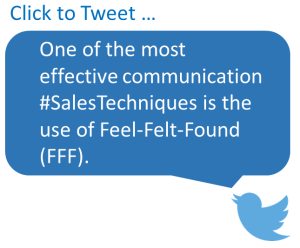 You will likely see many different kinds of buyers in your journey to become an elite salesperson; and many of these buyers will be different, value different things, think differently, and respond differently to various behaviors. Consequently, no matter how good you are, you’ll have to deal with buyer objections when trying to sell your product or service. This article describes 4 important tools to have in your “sales bag” that will help you overcome buyer objections.
You will likely see many different kinds of buyers in your journey to become an elite salesperson; and many of these buyers will be different, value different things, think differently, and respond differently to various behaviors. Consequently, no matter how good you are, you’ll have to deal with buyer objections when trying to sell your product or service. This article describes 4 important tools to have in your “sales bag” that will help you overcome buyer objections.
Tool 1 – Predicting the objections
If you’ve been selling your product/service for a while you probably know the most frequent objections buyers have. If you don’t have that experience, then ask one of the more experienced salespeople or others who understand the product/service. Thinking about and documenting the most frequent buying objections is a critical tool to successfully overcoming them.
When thinking about common objections, make sure you include the pricing objection. It may not always come up but it is likely on everyone’s mind and is something for which you should be prepared.
Tool 2 – Preparing good marketing statements
Once you’ve documented your most frequent sales objections, now you need to think about a strong marketing statement related to each objection. Marketing statements have two styles; one communicates why the buyer should buy your product/service, and the other is why the buyer should not buy from a competitor. Here are some examples…
- Why buy from you – “Our inventory control system is the only one on the market that provides real time updates. This will reduce labor costs because it prevents your warehouse people from searching for product that doesn’t exist.”
- Why not buy from a competitor – “Unlike the systems that our competitors sell, our system updates inventory levels real time, which will reduce your labor costs.”
Think about a good marketing statement associated with each of the objections you’ve identified earlier.
Tool 3 – Using empathy
Buyers are taking some level of risk every time they make a decision to buy a product or service, particularly purchases in the B2B space. So, a good salesperson should be empathetic to the buyer’s challenges and risks. As such, including empathy when you respond to objections is a way to strengthen your relationship with your buyer and improve the likelihood that you’ll close the sale.
One of the most effective communications techniques in a sales environment is the use of Feel-Felt-Found (FFF). Here’s how FFF works, along with an example…
|
Step |
An example of what you say… |
Why is this appropriate? |
| Step 1 – Feel – expressing empathy | “I understand why you’d be concerned about the length of time required to implement the system.” | You are acknowledging and empathizing the concern your buyer has expressed – not ignoring it. |
| Step 2 – Felt – making the buyer feel legitimate | “We’ve had other customers express a similar concern.” | You are validating and legitimizing the objection – not minimizing it in any way. |
| Step 3 – Found – giving another reason to buy | “What they found though is once the system is set up and operational, it produces savings at a rate faster than if you implemented a less robust solution.” | You are explaining how your solution overcomes the stated objection. |
By empathizing with the buyer and legitimizing his objection, you communicate an understanding that mitigates the risks and skepticism your buyer may be experiencing. Then, completing the FFF cycle with a marketing statement will mitigate the risk and overcome the skepticism.
[Learning what NOT to do is just as important as learning what to do. Check out How to improve sales – avoid the 7 deadly sins of salespeople.]
Tool 4 – Trial closing questions
Trial closing is not asking for the sale but rather asking how the buyer feels about the issues being discussed. The trial close is an open-ended, opinion-asking question that informs the salesperson where he is in the sales process. Here are some examples of trial closing questions:
- What do you think?
- How do you feel about that?
- How does this sound to you?
- How valuable is that to you?
- How do you feel that would help you?
Asking a good trial closing question often results in the prospect raising an objection. That’s not all bad. Objections help you understand what’s important to the prospect and what impediments there may be to making the sale. Additionally, trial closing questions enable you to see if you have successfully overcome the buyer’s objections.
[For more in-depth information on trial closing, read Trial Closings – The Key to a 100% Close Rate.]
Combining trial closing with FFF looks like this…
- You ask a trial closing question – “What do you think about that?”
- Buyer raises an objection, and you deploy the FFF method to respond to the objection.
- After making the marketing statement at the end of the FFF cycle, you ask another trial closing question, like “how do you feel that would help you?”
- The buyer might raise another objection and you repeat the above steps 1-3
You can overcome sales objections like a pro when you implement these 4 tools; determine what you expect the objections to be, prepare marketing statements that relate to the anticipated objections, show empathy to the buyer by deploying the FFF model, and always ask good trial closing questions to see where you are in the sales process.
To schedule a speaking engagement or just learn more about sales and marketing best practices, contact WebStrategies, Inc. online or by phone at 804-200-4545.






Agree, disagree, or just have something to add?
Leave a comment below.